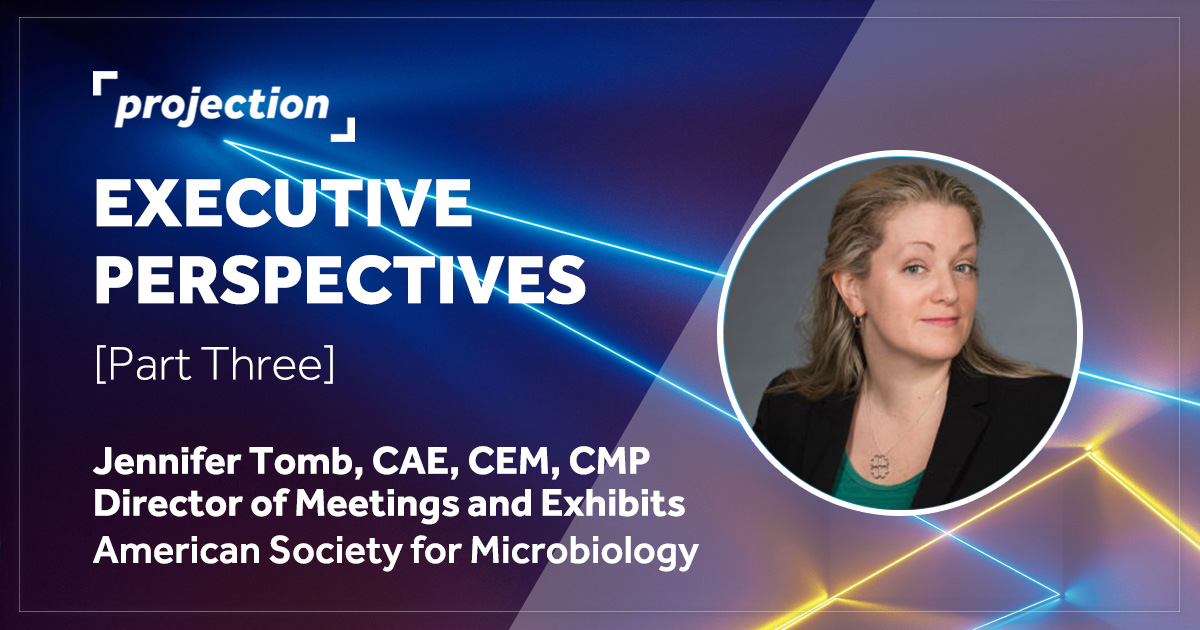
This is the third post in our “Executive Perspectives” series where we talk to association executives about opportunities and challenges the pandemic presented, how they’re creating value for their members and what lies ahead.
In this interview, we sat down with Jennifer Tomb, CAE, CEM, CMP, Director of Meetings and Exhibits for the American Society for Microbiology (ASM).
At the oldest life sciences society in the United States, learning is paramount. For its 30,000 members, the research, education, advocacy and career development ASM offers all work together towards a common goal: promoting and advancing the microbial sciences.
When barriers prevent learning from happening, it’s up to ASM’s meetings team to find a new way to make things happen.
Pivoting to Virtual to Stop the Spread
COVID-19 was one such barrier, and ASM found themselves quickly changing directions for their annual meeting planned for the summer of 2020. The meeting was canceled, and the ASM team was plunged into a new world of virtual offerings that none of them had much experience with on the level to produce the scope of the annual meeting.
“People who had been in the meetings industry for 10 or even 20 years were suddenly stepping into a whole new world. It was a baptism by fire into virtual and hybrid events. It was intense, but this period offered us great exposure to new tech. We started to see what might be possible now and in the future.”
This tech encompassed things like rapid fires––quick format talks that were pre-recorded and could be viewed at any time by the virtual audience, as well as live streaming sessions with interactive elements embedded into the program. There was also networking elements that allowed remote attendees to engage with speakers, poster sessions and more.
While some of the technology was more successful than others, it ultimately allowed more members to be part of the learning experience through whatever path made the most sense for them.
Diversifying Learning with a Hybrid Approach
Beyond the pandemic, ASM found other barriers that could be circumvented through virtual solutions.
This year, the delegation from Ukraine was unable to attend the annual meeting, but were given an integrated time slot to present their research as part of the otherwise in-person session. For ASM members, this hybrid approach opened up the floor to valuable speakers who may otherwise be unavailable, whether due to limited budgets, visa constraints or some other limitation.
While learning must go on, some members of ASM are still hesitant to gather physically in large groups. Others prefer to be physically present to conduct business, network and meet their peers. A hybrid meeting approach accommodates varied situations without compromising the experience for the rest of the members.
“The hybrid meeting is more inclusive of international scientists from lower and middle income countries, and students and early-career researchers with limited travel budgets, which are audiences critical to ensuring we are all on the cutting edge of microbial science. We cannot leave people – and their discoveries – behind simply because they can’t travel to a meeting.”
Making Content Consumable for Different Learning Styles
As a new generation of microbiologists enters the academic world and, eventually, the workforce, the way ASM curates and delivers content has evolved. As an organization, ASM serves the needs of many types of scientific professionals. Several years ago, ASM determined that, in order to best meet the learning goals of their community, they should stage a more personalized path for each attendee. To accomplish this, they set up a scientific track system that allows everyone to choose a hub, which helps them identify the sessions they are most likely to enjoy and find value from, and network with like-minded individuals throughout their conference experience.
The meeting is further divided into different types of sessions. More traditional long-form speeches are available, as well as fast-track presentations, open lounges, and of course, digital content. All of these options ensure that every member can find what they are looking for and learn about the concepts that are most useful at their current professional stage.
“We plan to continue with the hybrid approach. There will always be issues with travel, pushback on locations, and time constraints on our members. Streamed content that is well integrated with our live meeting components and the scientific track system help our members navigate their learning experience the way that works best for them. That helps us reach more people, which in turns advances the science of microbiology. And that is what we’re all about.”
More from “Executive Perspectives”
[Part One] with Kerry Crockett, CEO of Insurance Accounting and Systems Association (IASA)
[Part Two] with Beth Hayson, associate executive director of continuing education and meetings & exhibitions at the American Association of Oral and Maxillofacial Surgeons (AAOMS)
[Part Four] with Jay Brodsky, former Chief Digital Officer for the American Geophysical Union (AGU)
[Part Five] with Angela Keyser, executive director for the American Association of Physicists in Medicine (AAPM)
